High-Temperature Tribological Behavior of the Ti-22Al-25Nb (at. %) Orthorhombic Alloy with Lamellar O Microstructures
Abstract
:1. Introduction
2. Materials and Experiments
3. Results and Discussion
3.1. High Temperature Tribological Properties of Ti-22Al-25Nb Alloy
3.2. Wear Surface and Interface Analysis of Ti-22Al-25Nb Alloy
3.3. High-Temperature Friction Mechanism of Ti-22Al-25Nb Alloy
4. Conclusions
Author Contributions
Funding
Acknowledgments
Conflicts of Interest
References
- Banerjee, D.; Gogia, A.K.; Nandy, T.K.; Joshi, V.A. A New Ordered Orthorhombic Phase in a Ti3Al-Nb Alloy. Acta Metall. 1988, 36, 871–882. [Google Scholar] [CrossRef]
- Wang, W.; Zeng, W.; Sun, Y.; Zhou, H.; Liang, X. Microstructure, Tensile, and Creep Behaviors of Ti-22Al-25Nb (at.%) Orthorhombic Alloy with Equiaxed Microstructure. Materials 2018, 11, 1244. [Google Scholar] [CrossRef] [PubMed]
- Zheng, Y.; Zeng, W.; Li, D.; Zhao, Q.; Liang, X.; Zhang, J.; Ma, X. Fracture toughness of the bimodal size lamellar O phase microstructures in Ti-22Al-25Nb (at.%) orthorhombic alloy. J. Alloys Compd. 2017, 709, 511–518. [Google Scholar] [CrossRef]
- Wang, Y.; Cai, X.Q.; Yang, Z.W.; Wang, D.P.; Liu, X.G.; Liu, Y.C. Effects of Nb content in Ti–Ni–Nb brazing alloys on the microstructure and mechanical properties of Ti–22Al–25Nb alloy brazed joints. J. Mater. Sci. Technol. 2017, 33, 682–689. [Google Scholar] [CrossRef]
- Zheng, Y.; Zeng, W.; Zhao, Q.; Li, D.; Ma, X.; Liang, X.; Zhang, J. Deformation and microstructure evolution above the B2 transus of Ti-22Al-25Nb (at%) orthorhombic alloy. Mater. Sci. Eng. A 2018, 710, 164–171. [Google Scholar] [CrossRef]
- Lin, P.; Hao, Y.; Zhang, B.; Zhang, S.; Shen, J. Strain rate sensitivity of Ti-22Al-25Nb (at%) alloy during high temperature deformation. Mater. Sci. Eng. A 2018, 710, 336–342. [Google Scholar] [CrossRef]
- Wang, W.; Zeng, W.; Li, D.; Zhu, B.; Zheng, Y.; Liang, X. Microstructural evolution and tensile behavior of Ti2AlNb alloys based α2-phase decomposition. Mater. Sci. Eng. A 2016, 662, 120–128. [Google Scholar] [CrossRef]
- Zhang, J.W.; Li, S.Q.; Liang, X.B.; Cheng, Y.J. Research and application of Ti3Al and Ti2AlNb based alloys. Chin. J. Nonferrous Met. 2010, 20, 336–341. [Google Scholar]
- Wu, H.Y.; Zhang, P.Z.; Xu, Z. Study on nanomechanical and high temperature tribological behaviour of Ti2AlNb based alloys by plasma surface alloying. Surf. Eng. 2013, 24, 464–469. [Google Scholar] [CrossRef]
- Mi, G.; Yao, K.; Bai, P.; Cheng, C.; Min, X. High Temperature Oxidation and Wear Behaviors of Ti–V–Cr Fireproof Titanium Alloy. Metals 2017, 7, 226. [Google Scholar] [CrossRef]
- Li, C.X.; Xia, J.; Dong, H. Sliding wear of TiAl intermetallics against steel and ceramics of Al2O3, Si3N4 and WC/Co. Wear 2006, 261, 693–701. [Google Scholar] [CrossRef]
- Alam, M.O.; Haseeb, A.S.M.A. Response of Ti-6Al-4V and Ti-24Al-11Nb alloys to dry sliding wear against hardened steel. Tribol. Int. 2002, 35, 357–362. [Google Scholar] [CrossRef]
- Rastkar, A.R.; Bloyce, A.; Bell, T. Sliding wear behaviour of two gamma-based titanium aluminides. Wear 2000, 240, 19–26. [Google Scholar] [CrossRef]
- Miyoshi, K.; Lerch, B.A.; Draper, S.L.; Raj, S.V. Evaluation of Ti-48A1-2Cr-2Nb under Fretting Condition. NASA/TM—2001-211205; NASA Glenn Research Center: Cleveland, OH, USA, 2001. [Google Scholar]
- Cheng, J.; Li, F.; Qiao, Z.H.; Zhu, S.Y.; Yang, J.; Liu, W.M. The role of oxidation and counterface in the high temperature tribological properties of TiAl intermetallics. Mater. Des. 2015, 84, 245–253. [Google Scholar] [CrossRef]
- Hsu, S.M.; Shen, M.C.; Ruff, A.W. Wear prediction for metals. Tribol. Int. 1997, 30, 377–383. [Google Scholar] [CrossRef]
- XU, Z.S.; Zhang, Q.X.; Jing, P.X.; Zhai, W.Z. High-Temperature Tribological Performance of TiAl Matrix Composites Reinforced by Multilayer Graphene. Tribol. Lett. 2015, 58, 1–9. [Google Scholar] [CrossRef]
- Wang, L.; Zhang, Q.Y.; Li, X.X.; Cui, X.H.; Wang, S.Q. Severe-to-Mild Wear Transition of Titanium Alloys as a Function of Temperature. Tribol. Lett. 2014, 53, 511–520. [Google Scholar] [CrossRef]
- Rigney, D.A. Some thoughts on sliding wear. Wear 1992, 152, 187–192. [Google Scholar] [CrossRef]
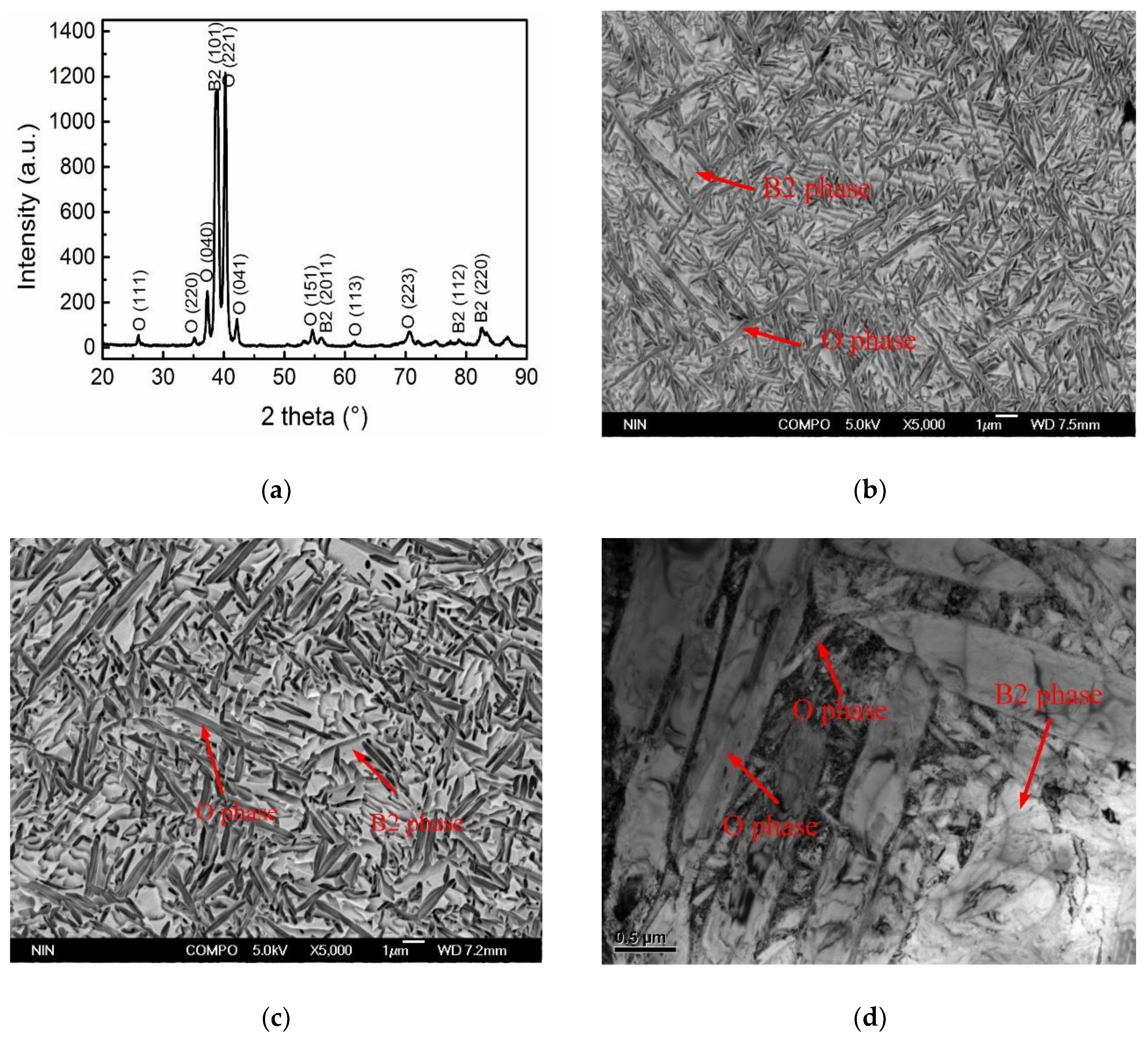
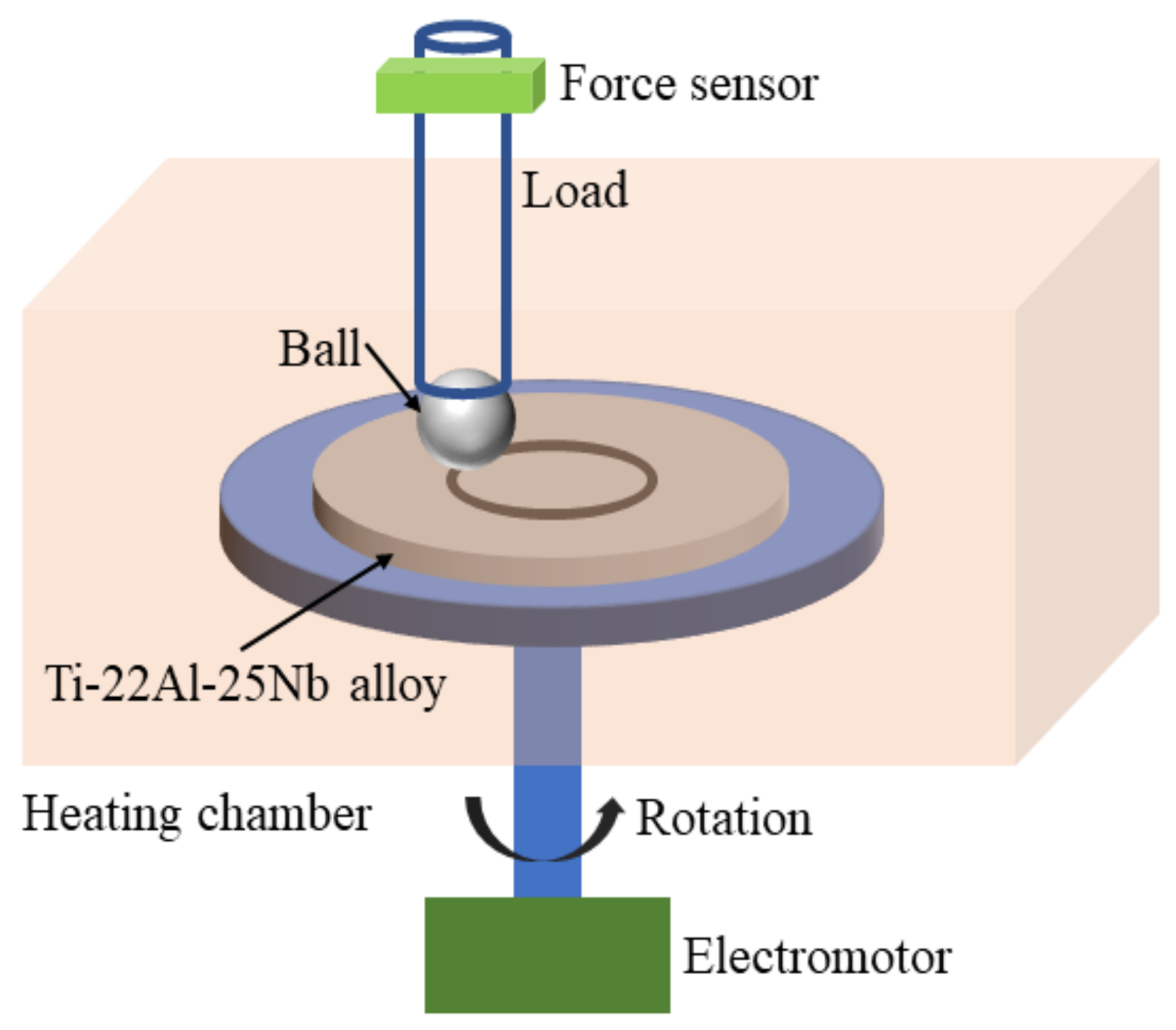

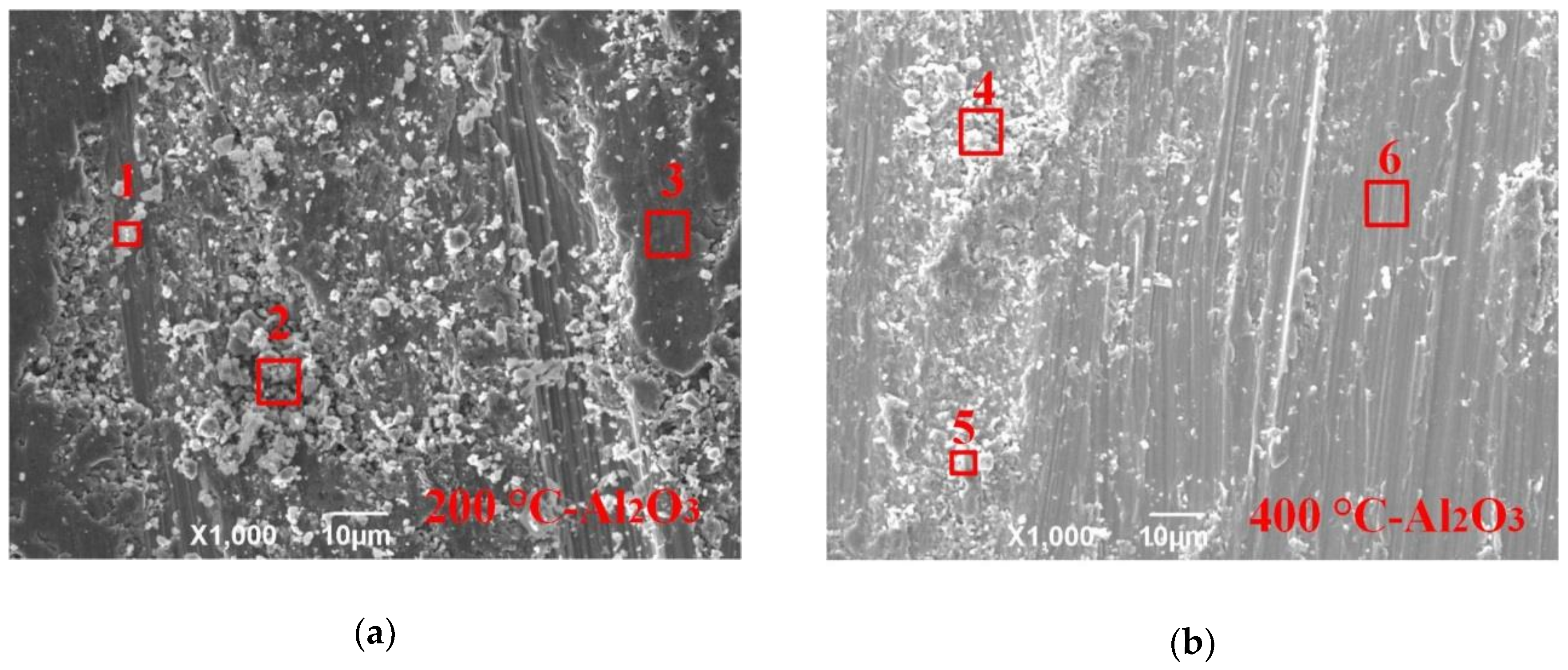

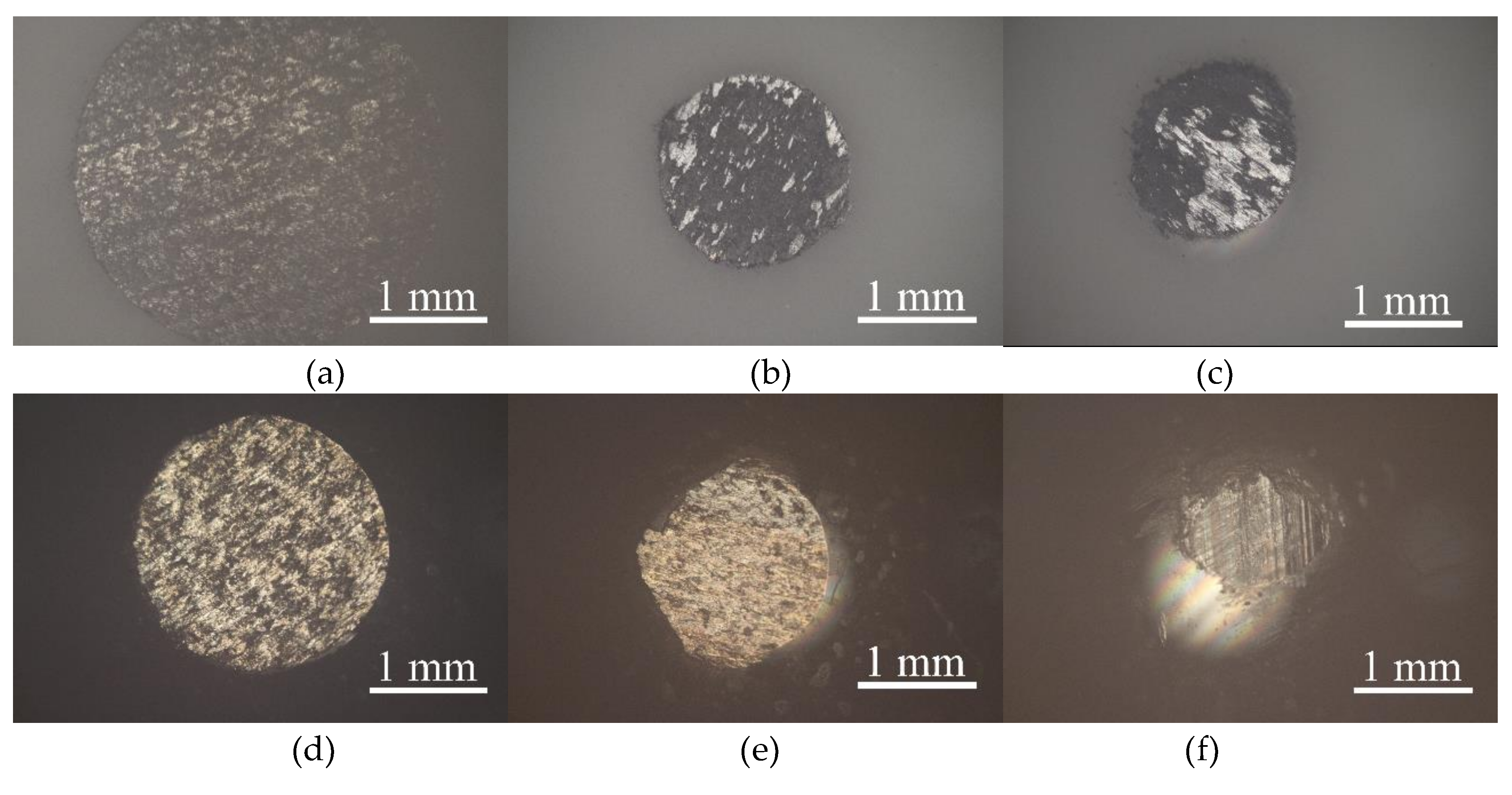



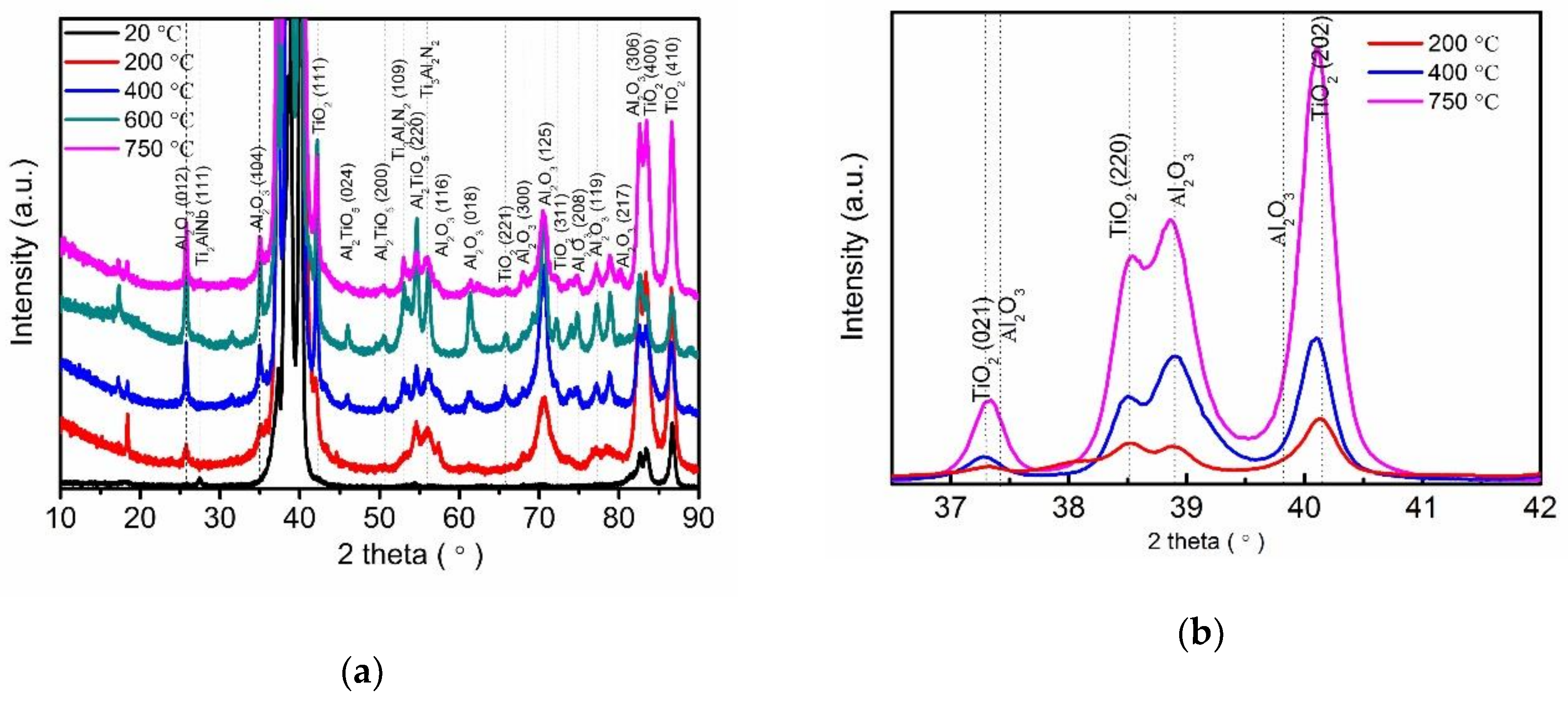
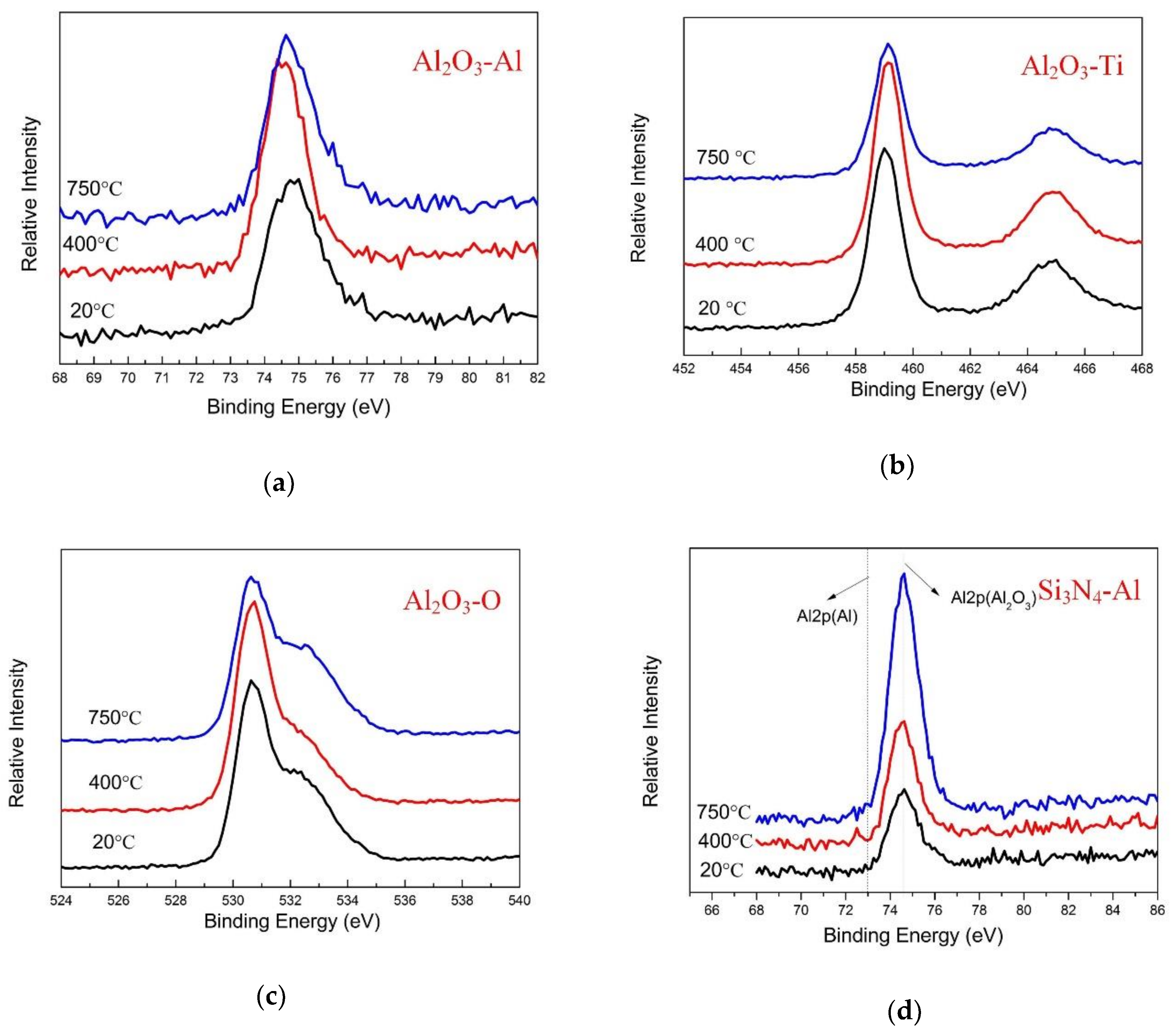

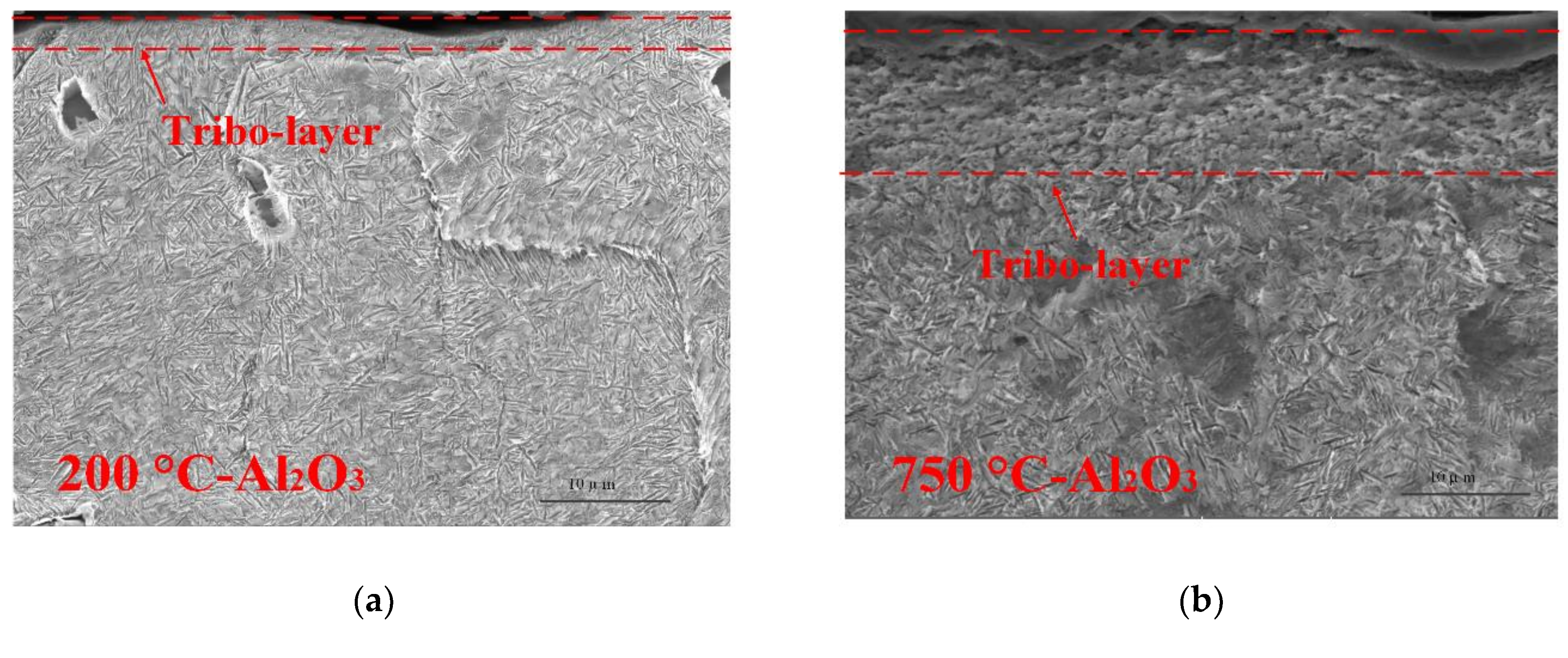
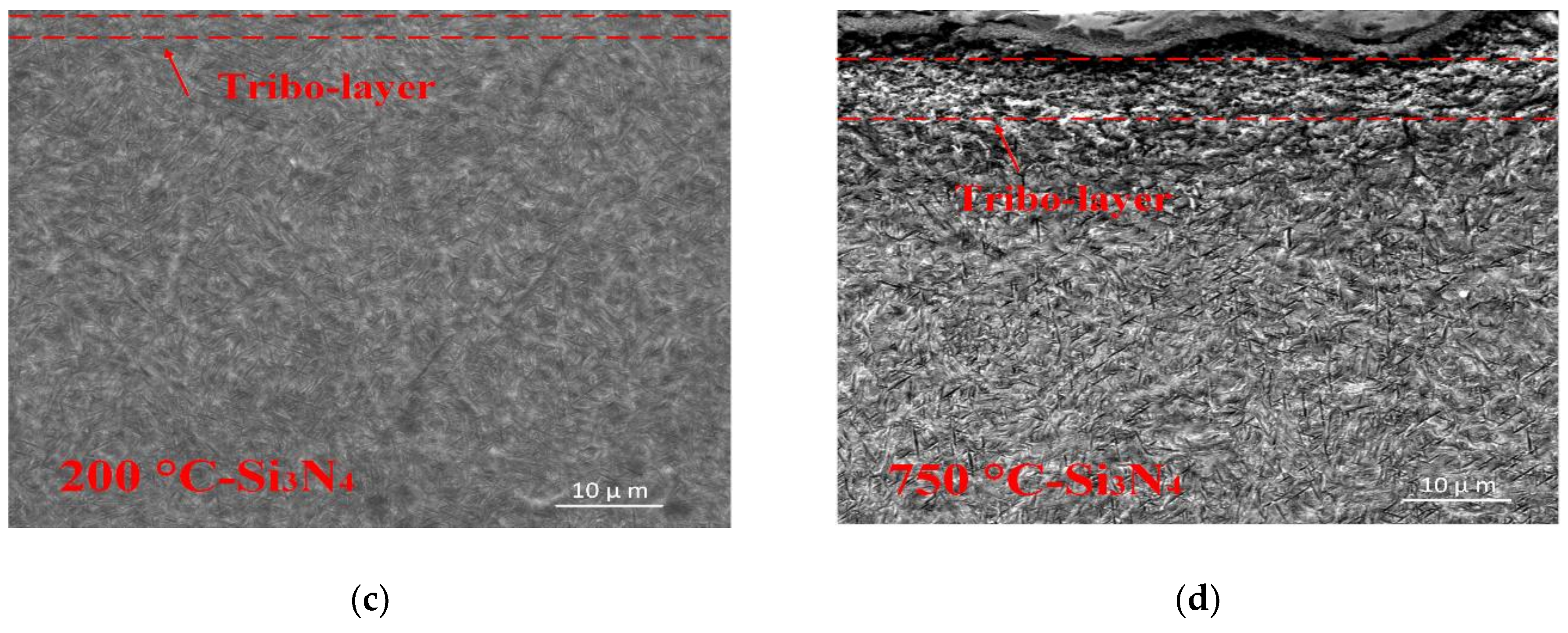
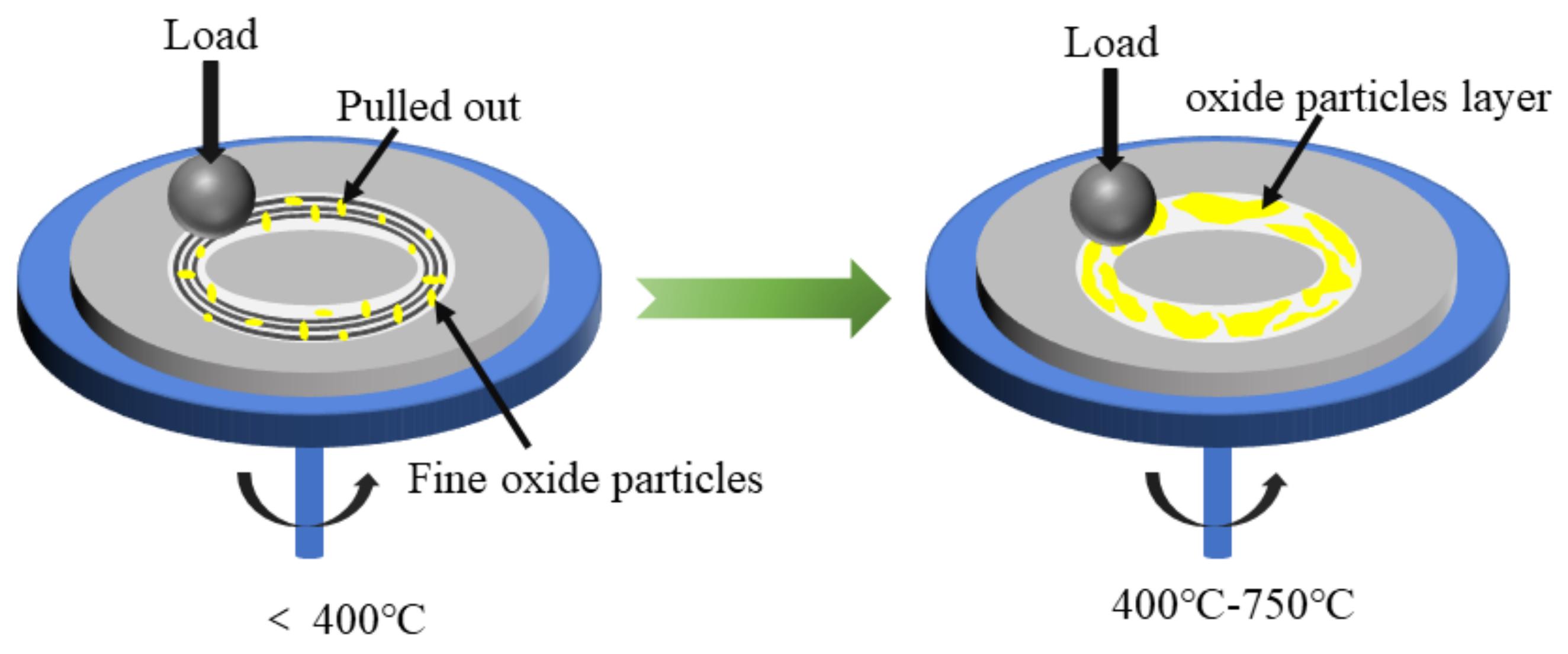
| Position | Testing Temperature (°C) | Average Composition (at.%) |
|---|---|---|
| 1 | 200 °C | O61.1Al23.5Ti9.9Nb5.5 |
| 2 | 200 °C | O47.8Al28.9Ti16.3Nb7.0 |
| 3 | 200 °C | O47.1Al31.4Ti14.0Nb7.5 |
| 4 | 400 °C | O56.0Al16.8Ti18.4Nb8.8 |
| 5 | 400 °C | O59.5Al17.1Ti15.3Nb8.1 |
| 6 | 400 °C | O24.8Al13.7Ti40.8Nb20.7 |
| 7 | 750 °C | O44.1Al9. 9Ti31.3Nb14.7 |
| 8 | 750 °C | O58.2Al7.6Ti22.9Nb11.3 |
| 9 | 750 °C | O57.6Al8.4Ti22.4Nb11.6 |
| 10 | 200 °C | O41.9Al11.3Si6.2Ti26.7Nb13.9 |
| 11 | 200 °C | O12.0Al16.1Si3.9Ti45.5Nb22.5 |
| 12 | 200 °C | O38.2Al11.4Si6.4Ti28.7Nb15.3 |
| 13 | 400 °C | O57.1Al8.6Si1.1Ti22.1Nb11.1 |
| 14 | 400 °C | O24.3Al13.3Si1.7Ti41.0Nb19.7 |
| 15 | 750 °C | O50.2Al7.7Ti28.6Nb13.5 |
| 16 | 750 °C | O45.4Al9.6Ti28.8Nb16.2 |
© 2018 by the authors. Licensee MDPI, Basel, Switzerland. This article is an open access article distributed under the terms and conditions of the Creative Commons Attribution (CC BY) license (http://creativecommons.org/licenses/by/4.0/).
Share and Cite
Wang, W.; Zhou, H.; Wang, Q.; Jin, J.; Sun, Y.; Wang, K. High-Temperature Tribological Behavior of the Ti-22Al-25Nb (at. %) Orthorhombic Alloy with Lamellar O Microstructures. Metals 2019, 9, 5. https://doi.org/10.3390/met9010005
Wang W, Zhou H, Wang Q, Jin J, Sun Y, Wang K. High-Temperature Tribological Behavior of the Ti-22Al-25Nb (at. %) Orthorhombic Alloy with Lamellar O Microstructures. Metals. 2019; 9(1):5. https://doi.org/10.3390/met9010005
Chicago/Turabian StyleWang, Wei, Haixiong Zhou, Qingjuan Wang, Jie Jin, Yaling Sun, and Kuaishe Wang. 2019. "High-Temperature Tribological Behavior of the Ti-22Al-25Nb (at. %) Orthorhombic Alloy with Lamellar O Microstructures" Metals 9, no. 1: 5. https://doi.org/10.3390/met9010005






